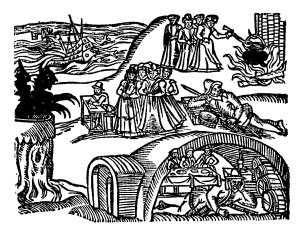DAEMONOLGIE

What was the book Daemonolgie about? who the book and when?
Magic, Witches, necromancy are the focus of ‘Daemonologie’ by the man who would become King James I of England, first published in 1597 when he was James VI of Scotland
INTRODUCTION DAEMONOLGIE:
Daemonologie was a book, written, and published by James VI of Scotland in 1597.The book included a study on demonology and the methods demons used to trouble men, while also touching on topics such as werewolves and vampires. It was a political yet theological statement to educate a misinformed populace on the history, practices and implications of sorcery and also supporting the reasons for persecuting witches. This book is said to be the main book, that supported William Shakespeare’s play, “Macbeth”, in 1606. Macbeth was performed in the court of King James, after he ascended to the English throne.

BACKGROUND OF THE TIME WHEN DAEMONOLOGIE WAS WRITTEN
The book was written in 1597, several years before the publication of the King James Bible. It endorses the practice of witch hunting in a Christian society. Presenting a vast conspiracy, that witches were threatening the nation. The book came across to many as very alarming.
King James was influenced by his personal involvement in the North Berwick Witch Trials, which happened in 1590. James personally witnessed some of the tortures of the seventy people who had been accused of witchcraft. During some of the tortures of those accused. there had been a confession. That the ship that brought him his new wife back from Scandinavia to Scotland, had been cursed and that the great storms they had faced, were the workings of the devil.
The book was published in England, in 1603, when he ascended to the throne. Influences from that time can still be seen. Even in our age, we can see in the King James Bible, where it says, “thou shall not suffer a witch to live”, wad changed from “Thou shall not suffer a poisoner to live “. Exodus 22:18.
There are two main characters in the book, Philomathes and Epistemon, who debate on various topics on magic, witchcraft, sorcery and demonology.
King James says he used the technique he does, to entertain the reader. The main plot is the character Philomathes. Philomathes hears of news of rumours on witchcraft in his kingdom, and he looks for and finds a philosopher named Epistemon, who has to allot knowledge on these subjects.
Demonology is in a form of three Books
Book one:
This first book follows the description of magic
-
The division of the various magical arts with a comparison between Necromancy and witchcraft
-
The use of charms, circles and conjurations
-
The division of Astrology
-
The Devil's contract with a man
-
Comparisons between the miracles of God and the devil
-
The purpose of these practices

Book Two:
This book is on the description of sorcery and witchcraft:
-
The difference between biblical proof and imagination or myth
-
The description of Sorcery and its comparison with Witchcraft
-
The path of a sorcerer's apprenticeship
-
Curses and the roles of Satan
-
The appearance of devils; the times and forms which they appear
-
The division of witch’s actions
-
Methods of transportation and the illusions of Satan
Book Three:
The third book is a conclusion on the whole dialogue. In this James gives a full description of spirits and spectre things that trouble men and woman. He states that the devil has the power and the ability to come in all shape and forms an array of purposes as well. In his description, he says demons are under the supervision of God, and unable to act without supervision. He goes on to say that demons are used as rods of correction when men stray from God.
The demonic forces were described as follows:
-
Spectra: Used to describe spirits that trouble houses or solitary place
-
Obsession: Used to describe spirits that follow upon certain people to outwardly trouble them at various times of the day. Referencing Incubi and Succubae
-
Possession: Used to describe spirits that enter inwardly into a person to trouble them.
-
Fairies: Used to describe illusionary spirits that prophesy, consort, and transport their servants




